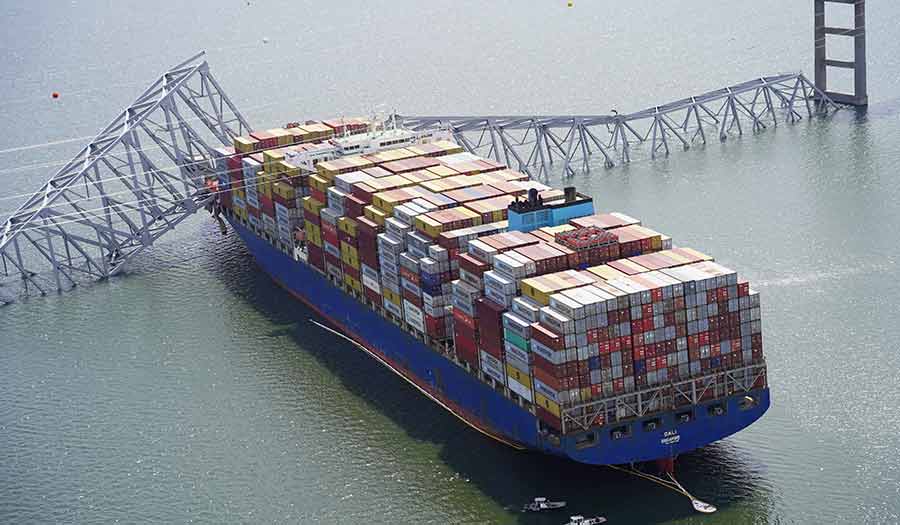 Maryland National Guard/Handout via REUTERS
Maryland National Guard/Handout via REUTERS
World News Desk
Learn the why behind the headlines.
Subscribe to the Real Truth for FREE news and analysis.
Subscribe NowReuters – The collapse of Baltimore’s Key Bridge has highlighted what engineers say is an urgent need to better protect the piers holding up spans over shipping channels as the size of cargo ships has grown in recent decades.
Federal authorities continue an investigation into why a massive cargo ship lost power and crashed into a pier of the Francis Scott Key Bridge early Tuesday, bringing down the structure and killing six workers who had been filling potholes atop it.
The Maryland Transportation Authority did not respond to questions about what, if any, protections were in place for the Key Bridge’s foundation piers—which bore the weight of the structure and all the vehicles on it—and whether updates might have been needed.
“The construction code has got to do better,” said Erin Bell, chair of the College of Engineering and Physical Sciences at the University of New Hampshire and an expert on bridge engineering. “Our job as engineers and our duty to society is that we learn from these failures.”
Bridges such as the one in Baltimore are classified as “fracture critical” by the federal government—meaning that if one portion of the bridge collapses, it is likely to take down the rest of the structure with it. According to the Federal Highway Administration, there are more than 16,800 such spans in the U.S.
U.S. Transportation Secretary Pete Buttigieg said on Wednesday that the Key Bridge “was simply not made to withstand a direct impact on a critical support pier from a vessel that weighs about 200 million pounds.”
Ms. Bell and other engineers said that while that is correct, it does not address the serious questions about what safety measures could have prevented the cargo ship from running into the pier, or absorbed the crush of the impact to keep the foundation intact.
Ms. Bell pointed out that the Key Bridge was opened in 1977—three years before a similar vessel collision of the Sunshine Skyway Bridge in Tampa Bay, Florida, killed 35 people, and prompted bridge designers to implement better protections for foundation piers.
Some of those measures include beefy fenders that push errant ships away from the piers, groups of pilings called “dolphins” that act as safety rings around foundations, or even just mounds of rock and earth.
“Why wasn’t there a retrofit for the Key Bridge? Especially when you see that the nearby Delaware Memorial Bridge is undergoing a vessel collision protection upgrade right now?” Ms. Bell said. “There should have been planning for this, given the size of vessels that were going by.”
Donald Dusenberry, a Massachusetts-based longtime forensic structural engineer who has focused on preventing bridge collapses, said from photos he has seen of the Key Bridge, it did not appear to have much of a defensive system around its piers.
“It looks like there was some cushioning in the form of wooden or some other kind of barrier, but it pretty much looks like it was attached to the pile cap at the bottom of the piers,” he said. “And that doesn’t absorb much energy.”
Mr. Dusenberry, like Ms. Bell, said that until the National Transportation Safety Board finalizes its investigation into the disaster, it is impossible to say with any certainty what may have lessened the impact of the ship. But in general, he said, a strong protective structure built far enough around the foundation pier to prevent a ship’s bow from striking the bridge was needed.
Rachel Sangree, an engineering professor at Johns Hopkins University in Baltimore, said she understood both why many people were stunned at video of the Key Bridge’s collapse, and why the focus on what went wrong is on protecting the bridge’s foundation piers.
But she underscored that the collapse was the result of an as-yet understood power failure on the cargo ship that sent it off course just as it approached the foundation of the bridge.
“I mean, that’s just terrible, terrible timing,” Ms. Sangree said. “It’s a horrible accident.”
- Real Truth Magazine Articles
- AMERICAS
 What’s Behind the Housing Crisis for Older Americans?
What’s Behind the Housing Crisis for Older Americans?
More on Related Topics:
- As Donald Trump Threatens Mass Deportations, Central America Braces for an Influx of Migrants
- Suicides in the U.S. Military Increased in 2023, Continuing a Long-term Trend
- Masses Flee Homes in Haiti as Gangs Ratchet Up Violence amid Political Turmoil
- Haiti Sees a Rise in Killings and Police Executions with Children Targeted, UN Says
- Thousands Survived a Brutal Gang Attack in Haiti that Killed 70. Now They Face an Uncertain Future


